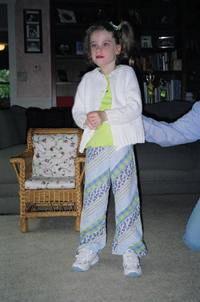|
||
      |
Breathing lessons
By the time her daughter reached her first birthday, Monica Coenraads knew something wasn’t right. “She couldn’t get herself into a sitting position,” Coenraads says. “She was rolling over fine, but she was not crawling. She was not pulling herself up to stand.” After that, Chelsea missed other developmental milestones; three weeks after saying her first word, “duck,” she fell silent. Her motor skills began to slip, and she lost the use of her hands. At 14 months, Chelsea withdrew. “She wouldn’t look at us,” Coenraads recalls. “We would call her name, but she would not turn, she wouldn’t respond.” She stopped playing with her toys, and sometimes she screamed. “She was happy only in her crib, only when she was left alone.”

Erratic breathing makes eating and walking harder for Rett syndrome
sufferers like 9-year-old Chelsea Coenraads.
Coenraads began researching her daughter’s symptoms online, and at age two, a formal diagnosis confirmed what she had begun to suspect: Chelsea had Rett syndrome, a debilitating neurological disorder that almost exclusively strikes girls. Often misdiagnosed as autism or cerebral palsy, it slows head growth and causes constant hand-wringing and gait abnormalities. Rett children struggle with motor control and speech. Many of them—the syndrome ranges from mild to severe—suffer seizures and irregular breathing, as well as maladies like scoliosis, gastrointestinal problems, difficulty chewing and swallowing, and malnutrition. “There are lots of variations of the phenotype,” says Jan-Marino Ramirez, a Chicago organismal biology and anatomy professor who began studying Rett syndrome six years ago. “Some children sit in a wheelchair and can’t move; some go to school,” either with mainstream children or in special-education programs with other Rett girls. Like Chelsea, they usually develop normally at first, then stagnate and regress. Cognizant and curious about the world around them but increasingly powerless to engage it effectively, they can grow agitated quickly. No longer withdrawn, at age nine Chelsea now labors to communicate. “It is absolutely tragic for the family,” Ramirez says. “It’s a progressive disease that shows no mercy.”
Recognized worldwide only 23 years ago, in 1999 Rett syndrome was traced to a mutation in a gene called MECP2. Established remedies remain more therapeutic than pharmaceutical, but recent research by Ramirez and his collaborators suggests that antidepressants and attention-deficit/hyperactivity disorder (ADHD) drugs may ease one of Rett syndrome’s most obtrusive and dangerous symptoms: erratic breathing. “As soon as she wakes up, it starts,” Coenraads says. Chelsea holds her breath (sometimes for as long as a minute), swallows air and hyperventilates. “She sticks her stomach out,” and during intense episodes her face turns red and the veins on her neck stand out. “This can go on for hours and hours and hours,” Coenraads says. “If you tried to mimic her breathing pattern, you would pass out. It makes everything else more difficult—eating, walking, going to school.”
Respiratory arrhythmia accounts for a quarter of Rett syndrome deaths, and, partly because breathing appears outwardly to normalize during sleep, clinicians long blamed cerebral cortex problems. “But,” Ramirez says, “we found something else.” His team noticed Rett children exhibit sagging levels of norepinephrine, especially in the medulla, the brain’s breathing center. “Norepinephrine is a neural modulator,” Ramirez explains. “It’s a pacemaker that actually synchronizes the neural network so you can have a breath.” In a study funded in part by the Rett Syndrome Research Foundation, founded in 1999 by Coenraads and other Rett parents, Ramirez isolated half-millimeter slivers of still-functioning breathing-center tissue from mice engineered to have the same genetic mutation as Rett children. The rhythm was erratic until he added norepinephrine. “When we did that, the breathing in the experimental model went from very abnormal to normal,” Ramirez says. (Untreated, Rett-mutated mice develop irregular breathing a month or two after birth, a condition that becomes fatal within weeks.) “Now we need to create a drug that will compensate for the disrupted neuromodulatory drive,” Ramirez says. His team plans to begin by testing the effectiveness of existing norepinephrine uptake blockers like Strattera.
Ramirez wants to look beyond breathing, however. He and his collaborators discovered that disordered rhythms in a mouse’s breathing tissue didn’t immediately lead to troubled breathing. Instead, Ramirez suggests, the nervous system initially might offset the shortage with other neuromodulators like serotonin and substance P, which play a role in breathing and motor control. But those substances soon run out too, which in turn contributes to the cascade of symptoms Rett children suffer. Treatments that replenish the trio of chemicals—norepinephrine, serotonin, and substance P—could alleviate not only erratic breathing but also hand-wringing or abnormal walking. “We need to better understand the interaction between the three neuromodulators,” Ramirez says. “There are lots of drugs already on the market that act on them, but the effect of these drugs is very complicated, and it’s not easy to predict the outcome. It could be that we find a pharmaceutical cocktail.”
Although scientists still don’t know precisely how the MECP2 mutation causes Rett syndrome, Ramirez says the disorder is clearly not a neurodegenerative disease. “The nervous system is not in a functional state, but it does not continue to degenerate, the way it does with other diseases.” A cure, therefore, is not out of reach. “There is great hope for these children,” Ramirez says. “If we are able to bring the neural cells into a functional state, we should be able to heal them.”